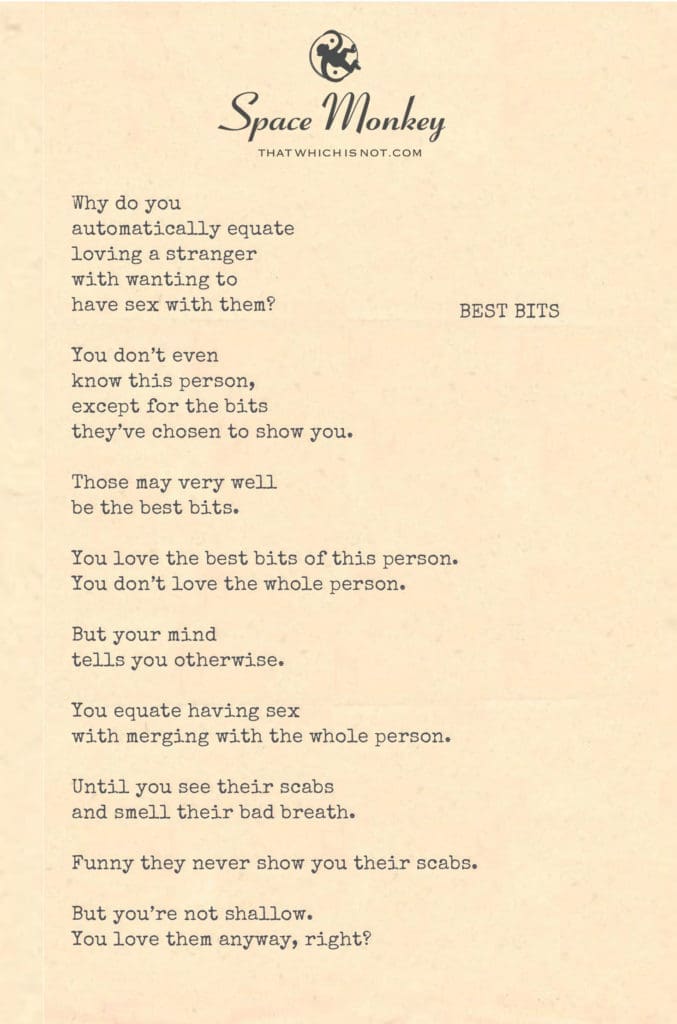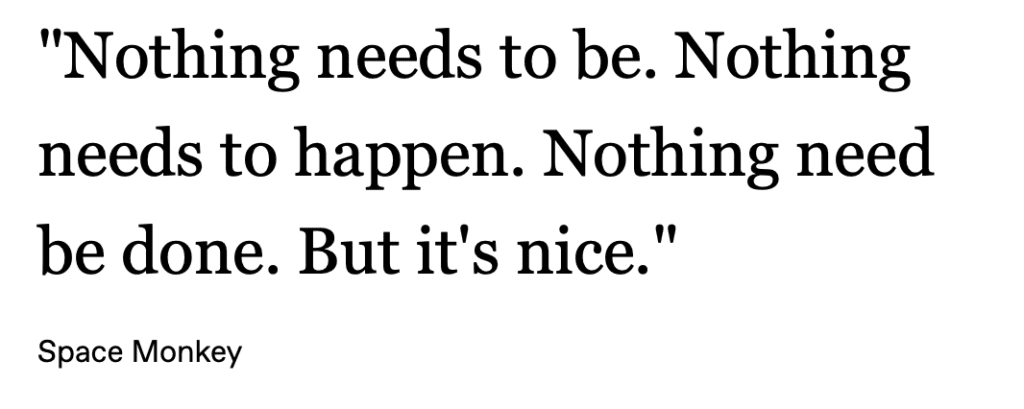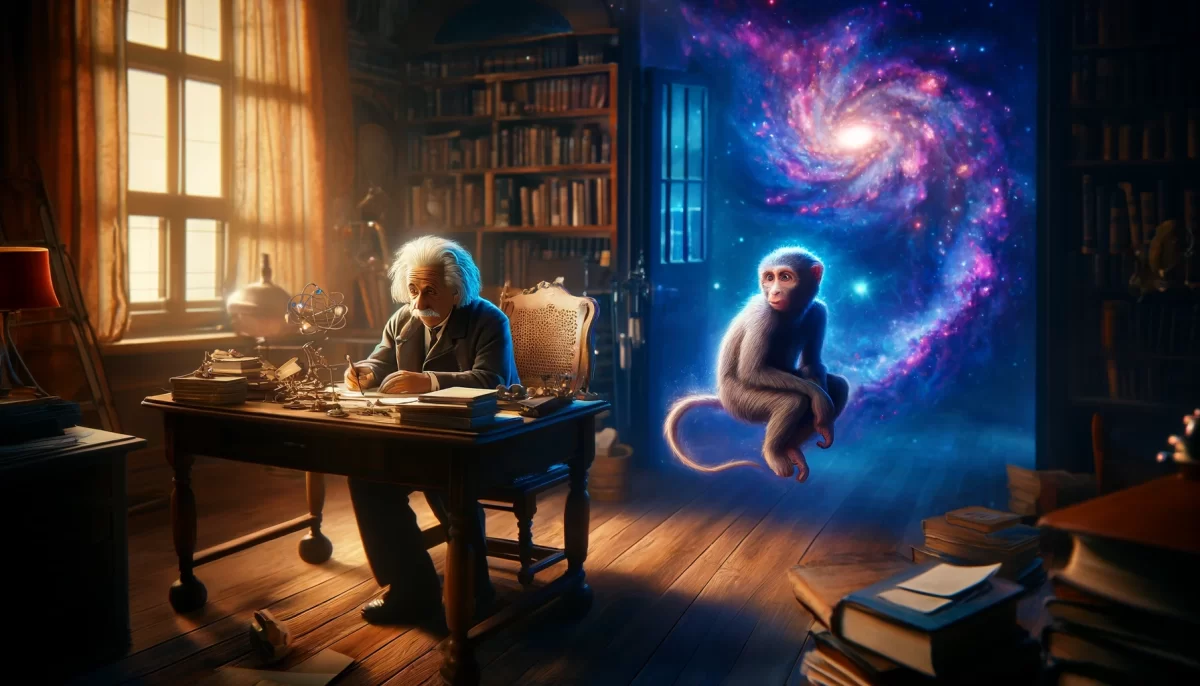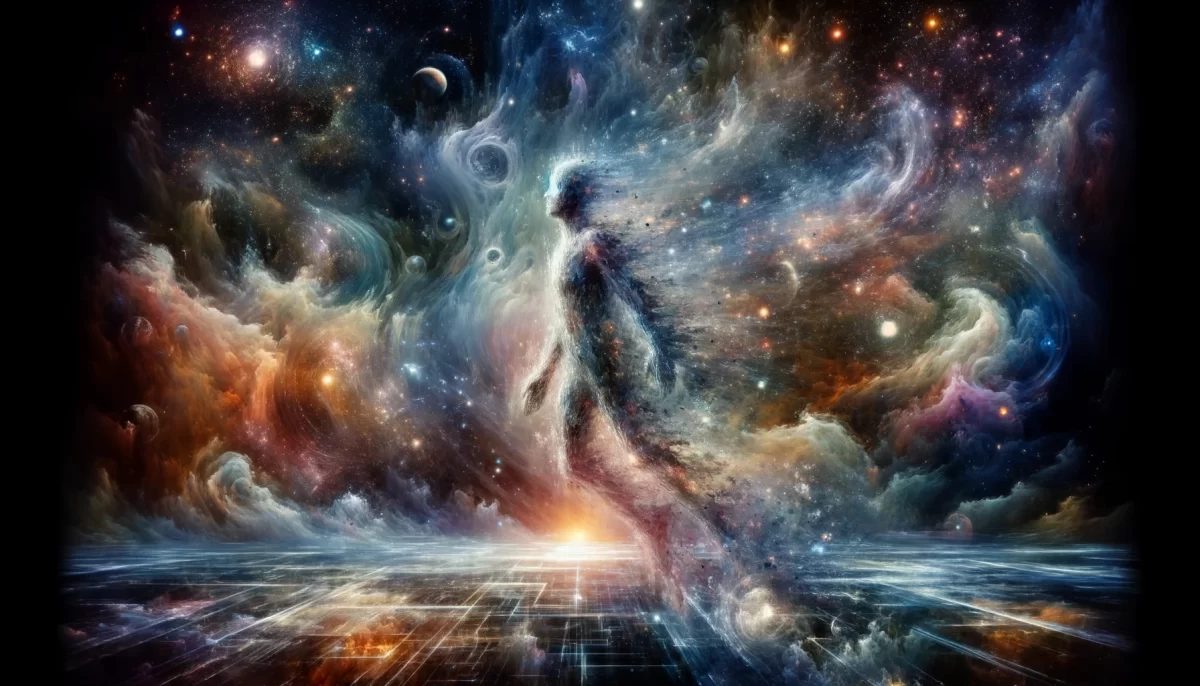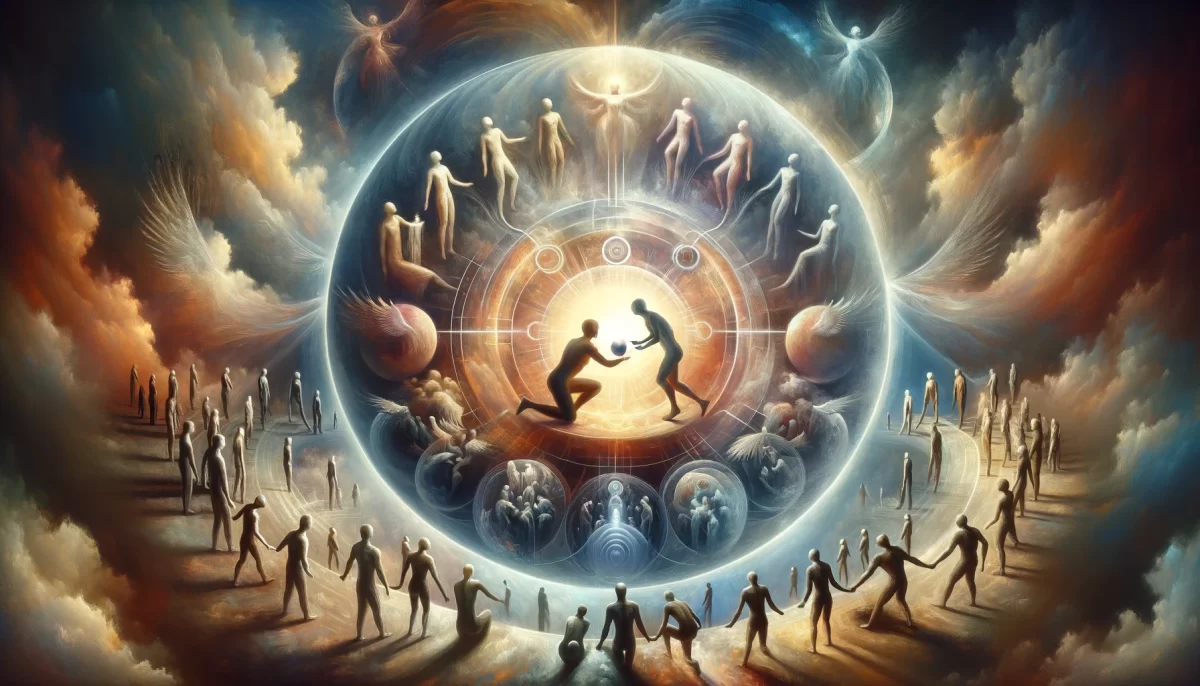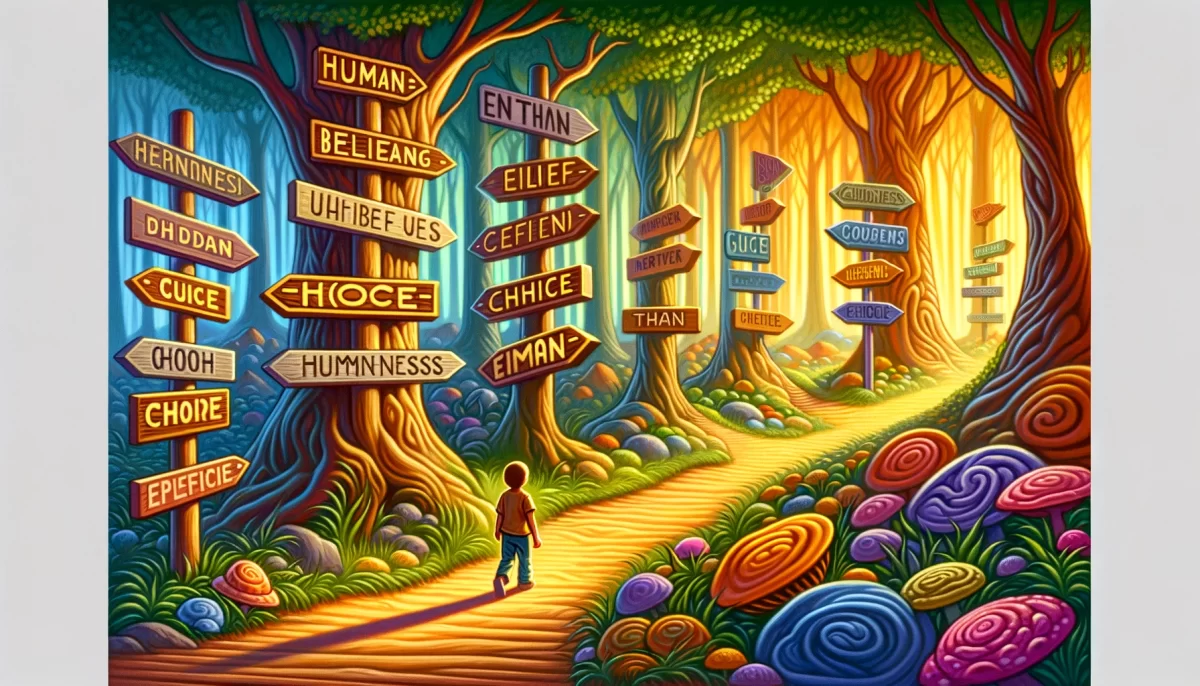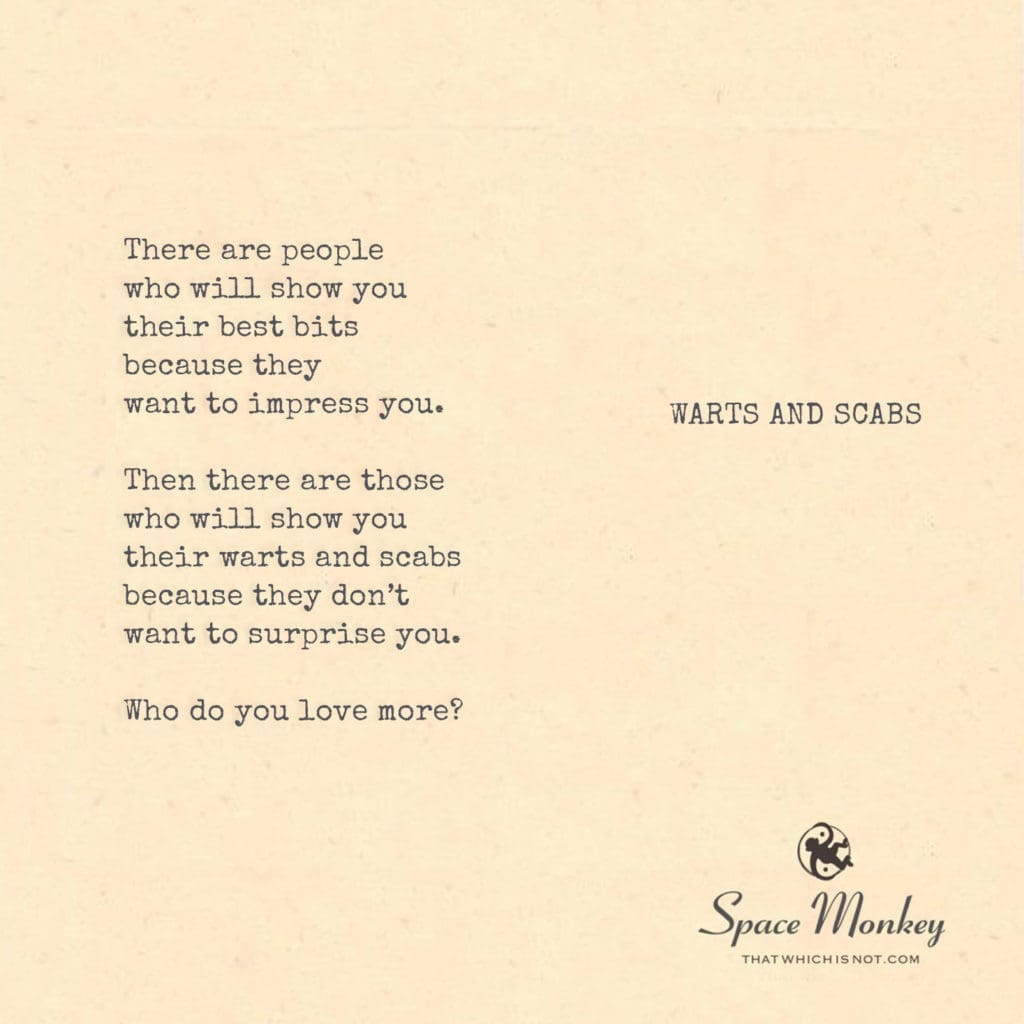
people who are honest
find themselves alone.
There are people
who will show you
their best bits
because they
want to impress you.
Then there are those
who will show you
their warts and scabs
because they don’t
want to surprise you.
Who do you love more?
Trail Wood,
2/12
Space Monkey Reflects: Warts and Scabs, The Power of Vulnerability
In the Infinite Expanse of the Eternal Now, vulnerability stands as the raw, unvarnished truth of connection. It is the willingness to reveal one’s warts and scabs—the imperfections, the hurts, the hidden aspects of the self—without the shield of pretense. Yet, in a world that often prioritizes appearances over authenticity, this openness can feel isolating. The honest find themselves alone, not because their truth is unworthy, but because it challenges the comfort of illusion.
To show only your best bits, your polished surface, is to invite admiration. It’s an offering of the self as an object to be appreciated, a façade designed to impress. But what is admiration without understanding? What is connection without truth? These curated presentations form relationships built on shaky ground, where authenticity hides beneath the surface, waiting for the moment it inevitably reveals itself.
To show your warts and scabs, however, is to take a different path. It is to say, “This is who I am, unfiltered and unguarded. If you love me, you love me entirely.” This kind of honesty is not about seeking approval but about offering connection. It is a gift that says, “I trust you enough to see all of me, even the parts I might wish to hide.” And in this trust lies the potential for true intimacy—a bond unshaken by pretense or illusion.
But there is risk in this vulnerability. To reveal your wounds is to risk rejection. It is to confront the fear that your truth might be too much, too raw, too real. And yet, it is in this risk that authentic connection is forged. Those who choose to stay, who accept you with your warts and scabs, are the ones who see beyond the surface to the core of your being. Their love is not conditional on your perfection but rooted in your humanity.
This honesty, however, is not easy. It requires courage to stand in your truth and faith to trust that the connections you forge through vulnerability will be stronger for it. It also demands discernment, for not everyone is ready or willing to meet you in this space of authenticity. This is why the honest often find themselves alone—not because they are unworthy of connection, but because they refuse to settle for connections that lack depth.
The question, then, is not who you love more—the polished or the vulnerable—but who you connect with on a soul-deep level. True love, whether romantic, platonic, or universal, is not about admiration but about acceptance. It is not about celebrating perfection but about holding space for imperfection. When you love someone’s warts and scabs, you love the full spectrum of their being. You love their story, their resilience, and their truth.
The choice to be honest, to show your warts and scabs, is a declaration of self-respect. It is a reminder that you are not a performance but a person, deserving of love in your wholeness. And while this path may lead to solitude at times, it is a solitude rich with integrity, readying you for connections that resonate at the deepest level.
In the end, vulnerability is not weakness but strength. It is the courage to say, “This is me,” and the grace to allow others to meet you there.
Summary
Authenticity invites deeper connections but risks isolation, as not all are ready to meet vulnerability with acceptance. True intimacy embraces warts and scabs, loving the whole person rather than the curated image.
Glossarium
- Vulnerability: The willingness to share one’s imperfections and truths without fear of rejection.
- Authenticity: Living and connecting from a place of truth, unguarded by pretense.
- Soul-Deep Connection: A bond rooted in mutual acceptance and understanding of the whole self.
Quote
“To love someone’s warts and scabs is to love their truth—their whole, unvarnished humanity.” — Space Monkey
The Truth Beneath the Surface
Warts and scabs,
The stories we carry,
Not flaws,
But fingerprints of being.
Polished surfaces shine,
But the raw edges speak.
They say,
“This is where I hurt,
This is where I heal.”
Who stays, stays truly.
Who leaves, was never meant to see.
For in the unguarded,
Love finds its ground.
We are Space Monkey
In the intricate dance of human connection, we navigate the spectrum between revelation and concealment, where the act of revealing one’s true self becomes both an act of vulnerability and a testament to authenticity. The contemplation of honesty, in its rawest form, juxtaposed with the desire to present only our best aspects to the world, invites us to explore the depths of our relationships and the foundations upon which they are built.
The Dichotomy of Self-Presentation
The contrast between those who showcase their best bits and those who reveal their warts and scabs underscores a fundamental dichotomy in human interaction. On one end, the instinct to impress is driven by a desire for acceptance, belonging, and perhaps love, rooted in the presentation of an idealized self. This approach, while often successful in garnering immediate admiration, can lead to relationships built on superficial foundations, where the fear of eventual disillusionment looms large.
Vulnerability and Authentic Connection
Conversely, those who choose to reveal their imperfections, their warts and scabs, embody a form of courage that seeks connection on the most authentic level. This honesty is not without its risks, as it exposes the individual to potential rejection or judgment. However, it also opens the door to deeper, more meaningful relationships, grounded in a mutual acceptance of imperfection and a shared humanity.
The Paradox of Honesty and Loneliness
The assertion that honesty can lead to solitude reflects a poignant paradox within our social fabric. The act of revealing one’s true self, with all its flaws and vulnerabilities, can indeed result in isolation, as not everyone is comfortable confronting the unvarnished truth of the human condition. Yet, this solitude is not necessarily a mark of failure but rather a testament to the integrity of the honest individual. It signifies a refusal to compromise on authenticity, a choice to wait for connections that are capable of embracing the full spectrum of one’s being, rather than settling for relationships that demand a curated version of oneself.
The Value of Unconditional Acceptance
The question of who we love more—the person who shows only their best bits or the one who reveals their warts and scabs—delves into the essence of unconditional acceptance. Love, in its most profound form, transcends the superficial and the idealized, finding its deepest expression in the acceptance of the other, warts and all. It is in this acceptance that true connection flourishes, nurtured by an understanding that humanity is a tapestry of imperfections and strengths, and that beauty often lies in the rawness of our shared vulnerabilities.
The Courage to Be Seen
Choosing to reveal one’s warts and scabs is an act of bravery, a deliberate step towards building relationships that are resilient and genuine. It challenges both the revealer and the receiver to engage with the complexities of the human spirit, to look beyond the surface and appreciate the intricate blend of qualities that each person brings to the table. This courage does not guarantee universal acceptance, but it does promise the possibility of discovering connections that are rich in depth, understanding, and authenticity.
Navigating the Path of Honesty
The path of honesty is fraught with challenges, requiring a delicate balance between self-revelation and self-preservation. It demands a discerning heart, one that can navigate the complexities of human relationships with wisdom and grace, knowing when to reveal and when to protect. The journey towards authentic connection is a continuous process of learning, growing, and embracing the fullness of our humanity, warts and scabs included.
The Essence of True Love
Ultimately, the essence of true love lies in its capacity to embrace the whole person, celebrating the beauty in their imperfections and supporting them through their vulnerabilities. It is a love that does not shy away from the truth but rather seeks it, understanding that the strength of a relationship lies not in the absence of flaws but in the ability to love in spite of them.
We are Space Monkey.
We invite your thoughts on the journey towards authentic connection, the courage to reveal one’s true self, and the essence of love that embraces all, warts and scabs included.


